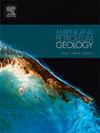Differential enrichment of middle-low maturity lacustrine shale oil in the late Eocene Shahejie Formation, Bohai Bay Basin
IF 3.7
2区 地球科学
Q1 GEOSCIENCES, MULTIDISCIPLINARY
引用次数: 0
Abstract
The Tertiary lacustrine shales in China display middle-low maturity but have significant resources potential for shale oil compared to North American marine shales. The accumulation mechanism of hydrocarbons in shales of middle-low maturity is of importance for the evaluation of shale oil resources and exploration. This study employs a comprehensive range of geological and geochemical methods to analyze the aggregation characteristics of hydrocarbons in the middle-low maturity lacustrine shales of the late Eocene first member of the Shahejie Formation (EOS shales) in the Bohai Bay Basin. Based on this analysis, the study proposes an aggregation pattern for hydrocarbons specifically in middle-low maturity lacustrine shales. The EOS shales are dominated by felsic minerals followed by clay and carbonate, and enriched Type II1 and Type II2 organic matter with an average TOC content of 2.03%. The presence of halite exhibits a positive correlation with the organic matter content, suggesting its important role in the preservation and concentration of organic material. The content of ankerite is negatively correlated with ΔS1 and positively correlated with OSI, indicating that ankerite promotes hydrocarbon enrichment. The free hydrocarbon index(ΔS1)was used to evaluate the hydrocarbon migration in EOS shales, and show differential enrichment in vertical profile as verified by multiple indicators. The mineral, lithology and lithofacies affect the enrichment of hydrocarbons. In the differential enrichment model, the hydrocarbons of Group Ⅰ enriched from outside, and the hydrocarbons of Group II were self-generated, while the hydrocarbons of Group Ⅲ expelled outward. This study clarifies the differential enrichment characteristics of hydrocarbons in middle-low maturity lacustrine shales, and proposed the enrichment model, which provides powerful support for the in-depth exploration and effective development of lacustrine shale oil.
渤海湾盆地晚始新世沙河街地层中低成熟湖相页岩油的富集差异
与北美海相页岩相比,中国第三纪湖相页岩的成熟度为中低,但页岩油资源潜力巨大。中低成熟度页岩中碳氢化合物的富集机理对页岩油资源评价和勘探具有重要意义。本研究综合运用地质、地球化学等方法,分析了渤海湾盆地晚始新世沙河街地层第一系中低成熟湖相页岩(EOS页岩)中碳氢化合物的聚集特征。在此基础上,研究提出了中低成熟度湖相页岩中碳氢化合物的聚集模式。EOS 页岩以长石矿物为主,粘土和碳酸盐次之,富含 II1 型和 II2 型有机质,平均总有机碳含量为 2.03%。海绿石的存在与有机质含量呈正相关,表明海绿石在保存和浓缩有机质方面发挥着重要作用。辉绿岩的含量与 ΔS1 呈负相关,与 OSI 呈正相关,表明辉绿岩促进了碳氢化合物的富集。利用游离碳氢化合物指数(ΔS1)来评价 EOS 页岩中碳氢化合物的迁移,多个指标验证了垂直剖面上碳氢化合物的富集差异。矿物、岩性和岩相都会影响碳氢化合物的富集。在差异富集模型中,Ⅰ组碳氢化合物从外部富集,Ⅱ组碳氢化合物自生,而Ⅲ组碳氢化合物向外排出。该研究阐明了中低成熟湖相页岩中碳氢化合物的差异富集特征,提出了富集模型,为湖相页岩油的深入勘探和有效开发提供了有力支撑。
本文章由计算机程序翻译,如有差异,请以英文原文为准。
求助全文
约1分钟内获得全文
求助全文
来源期刊

Marine and Petroleum Geology
地学-地球科学综合
CiteScore
8.80
自引率
14.30%
发文量
475
审稿时长
63 days
期刊介绍:
Marine and Petroleum Geology is the pre-eminent international forum for the exchange of multidisciplinary concepts, interpretations and techniques for all concerned with marine and petroleum geology in industry, government and academia. Rapid bimonthly publication allows early communications of papers or short communications to the geoscience community.
Marine and Petroleum Geology is essential reading for geologists, geophysicists and explorationists in industry, government and academia working in the following areas: marine geology; basin analysis and evaluation; organic geochemistry; reserve/resource estimation; seismic stratigraphy; thermal models of basic evolution; sedimentary geology; continental margins; geophysical interpretation; structural geology/tectonics; formation evaluation techniques; well logging.
 求助内容:
求助内容: 应助结果提醒方式:
应助结果提醒方式:


